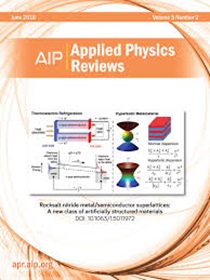基于离子动态电容实现光电调制的 MXene-TiO2 异质结构离子电子神经器件
IF 11.9
1区 物理与天体物理
Q1 PHYSICS, APPLIED
引用次数: 0
摘要
神经形态系统的开发需要使用能够适应光电调制的记忆电容器。具有原子级薄特征的二维(2D)材料及其衍生异质结构能够控制电荷载流子的局部转移,但有关二维材料支持电容式光电突触的报道尚未在实验中得到利用。在此,我们设计了基于离子动态电容实现光电调制的 MXene-TiO2 异质结构离子电子神经器件。根据电化学原理,在紫外光照射下,TiO2 中的光激发电子流向 MXene,导致电子作为捕获中心局部聚集,从而诱导 H+ 嵌入参与伪电渗析。当紫外光移除时,部分被捕获的 H+ 并不会立即恢复到初始状态。因此,这种记忆电容器在光电调制下具有滞后离子动态电容特性。通过评估其在神经形态计算中的适用性,该记忆电容器通过识别和锐化输入信号轨迹,实现了较高的手写数字识别准确率(93.5%)。本文章由计算机程序翻译,如有差异,请以英文原文为准。
MXene-TiO2 heterostructured iontronic neural devices based on ion-dynamic capacitance enabling optoelectronic modulation
The development of neuromorphic systems necessitates the use of memcapacitors that can adapt to optoelectronic modulation. Two-dimensional (2D) materials with atomically thin features and their derived heterostructures are able to allow for controlling local transfer of charge carrier but reports on 2D materials-enabled capacitive-type photoelectric synapses have not been experimentally exploited yet. Herein, MXene-TiO2 heterostructured iontronic neural devices based on ion-dynamic capacitance enabling optoelectronic modulation are designed. According to the electrochemical insight, under UV light illustration, photoexcited electrons in TiO2 flow to MXene, leading to the localized accumulation of electrons as the trapping center and thus inducing the embedding of H+ for participating in the pseudo-intercalation. On removing the UV light, a part of trapped H+ are not instantly returned to the initial state. As a result, this memcapacitor features hysteresis ion-dynamic capacitance under optoelectronic modulation. Through assessing its applicability to neuromorphic computing, this memcapacitor achieves the high recognition accuracy (93.5%) of handwritten digits by recognizing and sharpening the input signal trajectory.
求助全文
通过发布文献求助,成功后即可免费获取论文全文。
去求助
来源期刊

Applied physics reviews
PHYSICS, APPLIED-
CiteScore
22.50
自引率
2.00%
发文量
113
审稿时长
2 months
期刊介绍:
Applied Physics Reviews (APR) is a journal featuring articles on critical topics in experimental or theoretical research in applied physics and applications of physics to other scientific and engineering branches. The publication includes two main types of articles:
Original Research: These articles report on high-quality, novel research studies that are of significant interest to the applied physics community.
Reviews: Review articles in APR can either be authoritative and comprehensive assessments of established areas of applied physics or short, timely reviews of recent advances in established fields or emerging areas of applied physics.
 求助内容:
求助内容: 应助结果提醒方式:
应助结果提醒方式:


